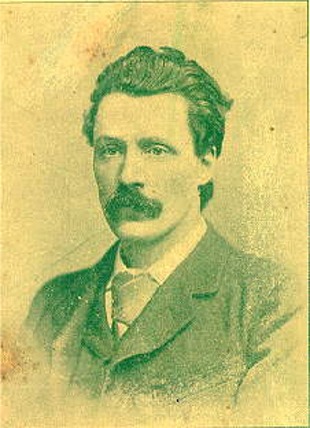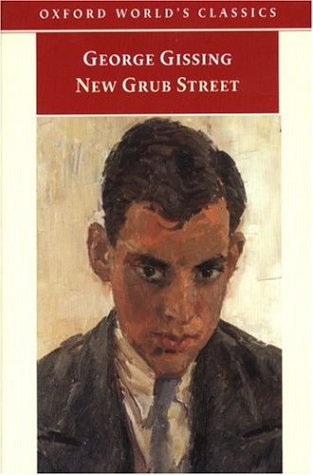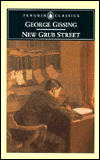George Gissing, New Grub Street, 1891
 New Grub Street is one of a very few novels which deal with the difficulties
of the work life, and with the systematic distortions of literary production
caused by marketplace conditions. Gissing wrote the novel in two months in
the autumn of 1890, at the pace of nearly 4,000 words a day, Reardon's rate.
It was published as a three-volume work, with the second volume arguably a
little padded. In this and in several other ways, New Grub Street may be said
to be a meta-novel, fictionalizing its author and the processes of its own
creation. Gissing was 33 at the time of its publication, the author of eight
previous novels, and he had rejected chances to tutor and write for periodicals
in order to continue writing fiction. The economic fates of Gissing's previous
novels resemble those of his hero's: his first book, Workers in the Dawn,
was published in 1880 at his own expense; The Unclassed was sold in 1884 for
thirty pounds, Isabel Claredon in 1886 for only fifteen, Demos in
1886 for 100 pounds, and New Grub, his best success thus far, for
150 pounds.
New Grub Street is one of a very few novels which deal with the difficulties
of the work life, and with the systematic distortions of literary production
caused by marketplace conditions. Gissing wrote the novel in two months in
the autumn of 1890, at the pace of nearly 4,000 words a day, Reardon's rate.
It was published as a three-volume work, with the second volume arguably a
little padded. In this and in several other ways, New Grub Street may be said
to be a meta-novel, fictionalizing its author and the processes of its own
creation. Gissing was 33 at the time of its publication, the author of eight
previous novels, and he had rejected chances to tutor and write for periodicals
in order to continue writing fiction. The economic fates of Gissing's previous
novels resemble those of his hero's: his first book, Workers in the Dawn,
was published in 1880 at his own expense; The Unclassed was sold in 1884 for
thirty pounds, Isabel Claredon in 1886 for only fifteen, Demos in
1886 for 100 pounds, and New Grub, his best success thus far, for
150 pounds.
He corrected proofs in February 1891, and wrote to his brother, "I am astonished to find how well it reads. There are savage truths in it." New Grub Street was the first of his books to achieve a second impression, but unfortunately he had sold it outright to Smith, Elder and Co.
The plot of Grub Street unites in a social milieu many people who 80 years later would have had different occupations--Reardon might have been a classical scholar and teacher, Yule a literary writer for magazines or encyclopedias, and Milvain a media entrepreneur well employed in writing for magazines and newspapers.
 Edwin Reardon's problems are in part ascribed to the circulating library system
of novel distribution. By the mid-nineteenth century, the three volume novel
had become dominant for economic reasons. A three volume novel cost 31s. 6d.,
far above the price an ordinary middle-class person could pay. Mudie's Circulating
Library charged an annual fee for each volume borrowed at one time, so purchase
of three subscriptions would have been needed to borrow an entire novel at
once. Since many people could only afford to read one volume before exchanging
it for another, the divisions between and within separate volumes had to be
designed to take advantage of this tri-partite structure. This mode of publication
encouraged padding and repetition, the adding of subplots, artificial conclusions
to each volume, sensational plot elements, and relatively empty romance and
adventure plots. When New Grub Street was translated into French in
1898 Gissing cut what he believed were superfluous conversations.
Edwin Reardon's problems are in part ascribed to the circulating library system
of novel distribution. By the mid-nineteenth century, the three volume novel
had become dominant for economic reasons. A three volume novel cost 31s. 6d.,
far above the price an ordinary middle-class person could pay. Mudie's Circulating
Library charged an annual fee for each volume borrowed at one time, so purchase
of three subscriptions would have been needed to borrow an entire novel at
once. Since many people could only afford to read one volume before exchanging
it for another, the divisions between and within separate volumes had to be
designed to take advantage of this tri-partite structure. This mode of publication
encouraged padding and repetition, the adding of subplots, artificial conclusions
to each volume, sensational plot elements, and relatively empty romance and
adventure plots. When New Grub Street was translated into French in
1898 Gissing cut what he believed were superfluous conversations.
In addition, Mudie's exerted censorship in sexual, political and religious matters, censoring controversy, morally unsavory protagonists and unhappy endings; Gissing and others believed that Mudie's guidelines virtually prescribed the novel of ideas. He also complained that protagonists had to be idealized; one of his heroines mentions that if altered a little, her life would make a good three decker novel.
Gissing was very conscious of the power of Mudie's; he reported to a friend that Workers in the Dawn was on Mudie's selected list for that year, 1880, and felt hopeful when he heard that Mudie's assistants were "keen" on his novels. His earliest novels, Workers in the Dawn, Mrs. Grundy's Enemies, and The Unclassed, conformed to the three volume convention. In A Life's Morning (1888) he tried to create a two volume novel but the publishers demanded three. In 1885 he had optimistically written his brother, "It is fine to see how the old three volume tradition is being broken through. One volume is becoming commonest of all. It is the new school."
However his next novel, The Nether World, was also forced to be in the conventional form. In 1892 he had to add an extra fourteen-page penultimate chapter to the three volume Born in Exile; the extra chapter expanded what had been brief remarks by a female protagonist on why she did not wish to marry a man born in a poorer class. Yet Gissing strove for a dramatic rather than an omniscient narrative presentation, in some ways closer to a spare, modernist style, and these elaborations were in his opinion flaws. He described his preferred "dramatic mode of presentment": "Far more artistic, I think, is the . . . method of merely suggestion; of dealing with episodes, instead of writing biographies. The old novelist is omniscient; I think it is better to tell a story precisely as one does in real life, hinting, surmising, telling in detail what can so be told and no more."
When Gissing intended to reprint his first novel, Workers in the Dawn, he cut dialogue, descriptions and authorial coments, including 22 pages of dialogue and 14 pages of description, and omitted generalized conversation from fear of being stigmatized as a "realist" by the critical world. Gissing's is thus one of the most clearly documented cases of a major author forced to meet demands of a form repugnant to him. Smith, Elder and Co. rejected Mrs. Grundy's Enemies with the comment, "It exhibits a great deal of dramatic power, . . . but in our judgement it is too painful to please the ordinary novel reader and treats of scenes that can never attract the subscribers to Mr. Mudie's Library." A later judgement confirmed that it was "sad almost beyond bearing." Smith, Elder also thought New Grub Street "clear and orignal," but feared "it is too gloomy." The lessons it conveyed were unfortunately in the form of examples to be avoided rather than followed.
A radical change occurred in the mid-1890s, however, as cheaper modes of publication arose. In 1894 184 three decker novels appeared, but in 1897, only seven! With the breakdown of the circulating library system, novels became shorter and less expensive.
 Chapter 1: What function is served by the opening scene in which Jasper
quarrels with his sister Maud? What major themes are introduced?
Chapter 1: What function is served by the opening scene in which Jasper
quarrels with his sister Maud? What major themes are introduced? - How is our view of Edwin Reardon affected by the fact that we first learn of him through Jasper's description?
- What is distinctive about Jasper's character and views? What kinds of writings does he aspire to produce, and how is are his talents and goals contrasted with those of Reardon and Biffen? What makes him as effective and successful as he is?
- What do we learn about the family finances from Maud's reaction to her brother? What proportion of the family income is represented by 120 pounds per annum? What wider social pattern is Gissing calling to the reader's attention?
- Chapter 2: What do we learn about the Yule family through hearsay? From narrative flashbacks? What forms of literary effort are critiqued or parodied by the account of Arthur Yule's life?
- What do we learn of the Yules and Milvains from the account of their visits? What do the visitors make of John Yule's hostility to reading?
- Chapter 3: What insights are provided by the scene in which Jasper and Marian view a passing railroad train? Are there elements of foreshadowing in this scene?
- How would you characterize the novel's narrative voice? Through what means does the author make his points? Which characters are granted the most chance to express themselves, or represented most fully from within?
- What purpose is served by gossip and indirection in the novel's construction?
- What is the relation between Edwin's literary fate and his physical and mental condition?
- If you had learned nothing about Gissing's politics from background sources, would you guess them from any authorial responses in the novel? (e. g. 50, 303)
- Does Reardon feel sympathy for the poor around him? What are his goals? Does he question the definition of respectability and success--a dependent wife, servants, and a good establishment?
- What seems to be the relationship between social class and education, as portrayed in this novel? What attitude does the novel seem to take toward those without education? (e. g. 71, 174, 189, 204-205, 211, 313, 352, 364)
- What importance is ascribed to linguistic correctness throughout the novel? What seems the relationship between speech and class status? According to the novel, is it ever possible to change class identity through education?
- Is the novel carefully structured? Is the sequence of incidents effective?
- How are the Reardon and Marian plots related? If Marian had been the heroine, would the novel have had a different focus?
- What is added to the novel by the assessment of the Yule family dynamics? To what does the narrator ascribe Mr. Yule's bad temper and rudeness to his wife? What motives prompt Mr. Yule to discourage Marian's relationship with Jasper?
- Can you discern proto-feminist elements in details of plot and characterization?
- What are the several kinds of literary hackwork presented, and what is
wrong with each? (as represented by Yule, Milvain, Fadge, Miriam, Dora, Maud,
and Whelpdale) What kind of literary work does Jasper propose for his sisters?
What motivations does each of the characters have for writing?
The magazine Whelpdale describes, Chit-Chat, patently refers to George Newnes' highly successful Tid-Bits, and to Alfred Harmsworth's imitation of it, Answers, both launched in the 1880s. - What are the ideals toward which Biffin and Reardon strive? How are these related to literary currents of the day? (Both eschew romance to seek a "truth" of ordinary life, a variant of materialist realism or psychological realism respectively.)
- Are the two major plots connected well? What is the significance of the contrasting fates of Edwin and Jasper? (Jasper rises while Edwin falls; each plodder is rejected by an ambitious partner.)
- Does each plot maintain approximately the same strength?
- What function does Biffin serve in the novel? Dora? Toward the end, Whelpdale?
- What is added by the account of Whelpdale's Chicago experiences? (cmp. Isabel Clarendon, Margaret Home)
- Do you agree with Bernard Bergonzi's contention that Jasper Milvain and Amy are presented fairly sympathetically?
- What are some parallels/contrasts between Jasper and Amy, or Jasper and Fadge? What is parodied in Jasper's new post at the Current, and his mode of reviewing?
- What are some unusual features of this book? (e. g. its sense of physical reality; its attention to what Biffin calls the ignobly decent--the problems of respectability and money in midle-class London; spelling out of the necessities of middle-class gentility; portrayal of marital arguments, change of tone, berating; a rare 19th century expose of literary world) What is unusual about its choice of hero?
- What are some of the forms of self-reference embedded in this novel? What are some of the ways it is directly autobiographical?
- Is Gissing adept at characterization? Is Reardon a believable person? Amy? Jasper? Do his characters change, develop, present surprises? (Reardon, Amy, Jasper, Miriam, Dora, Yule)
- Do you feel the author is sufficiently impartial in his treatment of Amy? (Rather surprisingly, two years later he wrote The Odd Women, portraying the problems of women facing loss of class status and starvation.)
- How effective are the scenes in which the couple quarrel? How would you compare Gissing's treatment of marriage with, say, that of Meredith in "Modern Love" or Eliot in Middlemarch?
- What assumptions underlie Amy's refusal to work, their shared assumption that their income must come from him or from inheritance, and Edwin's relative coolness toward his son?
- What are some parallels between Browning's "Andrea del Sarto" and the scene in which Edwin asks for his wife's companionship as he tries to reflect on their problems?
- What failures in understanding or choice cause Edwin and Amy's separation? Within the novel's frame of reference, can you see any way in which their situation could have been remedied (short of an inheritance!)
- What are some of the novel's basic themes? (e. g. the economics of literature and marriage; the commercialization of the literary marketplace; the limited possibilities of happiness for a sensitive man)
- Do you feel Gissing ends the novel well? Are Reardon's and Biffin's deaths sufficiently prepared for?
- What are causes of Biffin's death? Edwin's death? Willie's death? (with motif of son vs. husband) Do you find Amy's repentance explicable?
- What do you make of the novel's constant references to money? What intention lies behind them (breaking of taboo), and what cumulative effect do they have? Do you think this novel would lend itself to a marxist reading?
- What is the tone of the final scene in which the marriage of Jasper and Amy is presented? Is this an effective closure?
- How is the novel organized around geographical spaces? What importance seems given to modes of transportation. What social significance seems attached to the peripatetic London of tramways, omnibuses, and transient rentals?
- How is the attitude of each character toward classical study important? Why may this predilection have been chosen by Gissing as a symbol?
- What are some features of Gissing's style? Is it successful? Do you find the narrator's intrusions appropriate? (e. g. 106, 286, 351)
- What do you think of Edwin Reardon's views on the subject of marriage? (304) What effect does the Married Women's Property Act have on the plot? (This came into force in 1883) (cmp. Hardy's poem on the ill effects of workhouse reform)
- How effective are the novel's portrayal of family dynamics? Is the relationship between Arthur Yule and his daughter a somewhat unusual one for fiction of the time?
- What is the effect of Gissing's use of epigrammatic generalizations?
- Are there aspects of this work which seem to you incompletely developed or confusing? Are there inconsistencies in characterization or tone, and if so, to what do you attribute them?
- Do you find the reconciliation between Amy and Edwin credible? Is it consistent with her later rapturous marriage to Jasper?
- Are episodes of the novel sentimental or melodramatic, and if so, what effect do these have? Do you agree with the frequent comparisons of Gissing and Dickens?
- Can you see resemblances between New Grub Street and any novels by Hardy? (1886, The Mayor of Casterbridge, 1891 Tess of the D'Urbervilles, 1895, Jude the Obscure) What are some common themes? Are there parallels between Reardon and Jude?
- Are some/all of the aspects of the marketplace and its results still present
today? What seem the novel's most significant insights?
(e. g. marriage as an economic burden; sense that cultural life is decaying; the identification of education and class; the cutting short of possible happiness by death; the assumption that the artist and his/her society are in conflict)
Are there weaknesses of the novel on Gissing's own terms? (his characters the walking embodiment of ideas, 106; the presentation of child)
I find the identification of author and character at times obtrusive, and the moral excessively underlined (e. g. Jasper seems too self-accusing, 415)
The reviews of Mr. Bailey parallel those Gissing received, 401
Note: Bond Schools, 379, refers to primary schools established by the Education Acts of 1870
Specific passages for attention:
12 Jasper writes upper middle-class trash
32 pedanty of Yule
65 Reardon feels contempt for modern novels he writes
89-90 purposelessness of literary hackwork; British Museum Reading Room
103 dialogue easier than analysis
119 Biffin's literary ideals
120 Reardon's literary ideals
168 three-volume novel
298 Amy new woman produced by journalism
(page numbers from Riverside edition)